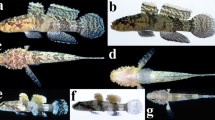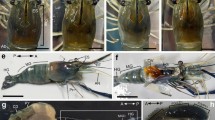Abstract
The morphology of pilidia ex gr. recurvatum from Peter the Great Bay (Sea of Japan) was studied by confocal laser scanning and transmission-electron microscopy. The studied pilidium larvae differ from pilidium recurvatum in lacking a posterior ciliary ring and by the presence of a caudal tuft. On this basis, pilidium prorecurvatum is proposed as a new name for the lavae. The apical organ of pilidium prorecurvatum is represented by a thickened epithelium, which consists of uniform columnar monociliary collar cells and is innervated by a pair of serotonergic intraepithelial neurons. The bodies of the serotonergic neurons are located outside of the apical organ, but occasional axons were found at the organ base. The rest of the pilidial epithelium is represented by flattened polygonal multiciliated cells with sparse microvilli; the bodies of two neurons lie in the helmet epithelium immediately adjacent to the apical organ. Morphologically, the apical organ of the pilidium corresponds well to that of other lophotrochozoan larvae, but their homology remains unclear.
Similar content being viewed by others
References
Ivanova-Kazas, O.M., Evolutionary Embryology of Animals, Saint-Petersburg: Nauka, 1995.
Magarlamov, T.Yu. and Chernyshev, A.V., Ultrastructure of larval epidermis of the nemertean Quasitetrastemma stimpsoni (Chernyshev, 1992) (Hoplonemertea), Russ. J. Mar. Biol., 2009, vol. 35, no. 1, pp. 22–28.
Maslakova, V.V. and Malakhov, S.A., Nemerteans of the order hoplonemertini have a hidden larva, Dokl. RAN, 1999, vol. 366, no. 6, pp. 849–852.
Chernyshev, A.V., The larvae of unarmed nemerteans in Peter the Great Bay (Sea of Japan), Russ. J. Mar. Biol., 2001, vol. 27, no. 1, pp. 58–61.
Chernyshev, A.V., Larval development of nemerteans of the Genus Quasitetrastemma (Nemertea: Monostilifera), Russ. J. Mar. Biol., 2008, vol. 34, no. 4, pp. 258–262.
Chernyshev, A.V. and Magarlamov, T.Yu., The first data on the nervous system of the larvae of the armed nemerteans (Nemertea, Hoplonemertea), Dokl. RAN, 2010, vol. 430, no. 4, pp. 571–573.
Schmidt, G.A., Alteration of ecological relations in adult individuals and evolution of embryogenesis on the example of Lineus desori and L. ruber, Zool. Zhurnal, 1962, vol. 41, pp. 162–193.
Andrade, S.C.S., Strand, M., Schwartz, M., et al., Disentangling ribbon worm relationships: multi-locus analysis supports traditional classification of the Phylum Nemertea, Cladistics, 2012, vol. 28, pp. 141–159.
Bürger, O., Nemertini (Schnurwürmer), H.G. Bronn’s Klassen und Ordnungen des Tierreichs, Bd. 4 (suppl.), Leipzig: C.F. Winter, 1897–1907.
Cantell, C.-E., Some developmental stages of the peculiar nemertean larva pilidium recurvatum Fewkes from the Gullmarfjord (Sweden), Ark. Zool., 1966, vol. 19, no. 5, pp. 143–147.
Cantell, C.-E., Morphology, development, and biology of the pilidium larvae (Nemertini) from the Swedish West Coast, Zool. Bidr. Uppsala, 1969, vol. 38, pp. 61–111.
Cantell, C.-E., Franzen, A., and Sensenbaug, T., Ultrastructure of multiciliated collar cells in the pilidium larva of Lineus bilineatus (Nemertini), Zoomorphology, 1982, vol. 101, pp. 1–15.
Dawydoff, C., Les formes larvaires de Polyclades et de Némertes du plancton Indochinois, Bull. Biol. France Belg., 1940, vol. 74, pp. 443–496.
Fewkes, J.W., On the development of certain worm larvae, Bull. Mus. Comp. Zool. Harvard Coll., 1883, vol. 11, pp. 167–208.
Hay-Schmidt, A., Catecholamine-containing, serotonin-like and neuropeptide FMRFamide-like immunoreactive cells and processes of the nervous system of the pilidium larva (Nemertini), Zoomorphology, 1990, vol. 109, pp. 231–244.
Hay-Schmidt, A., The evolution of the serotonergic nervous system, Proc. Roy. Soc. London., Ser. B, 2000, vol. 267, pp. 1071–1079.
Jägersten, G., Evolution of the Metazoan Life Cycle, a Comprehensive Theory, London: Academic Press, 1972.
Lacalli, T.C. and West, J.E., The nervous system of a pilidium larva: evidence from electron microscope reconstructions, Can. J. Zool., 1985, vol. 63, pp. 1909–1916.
Maslakova, S.A., The invention of the pilidium larva in an otherwise perfectly good spiralian Phylum Nemertea, Integr. Comp. Biol., 2010, vol. 50, pp. 734–743.
Maslakova, S.A., Development to metamorphosis of the nemertean pilidium larva, Front. Zool., 2010, vol. 7, p. 30.
Maslakova, S.A., and von Döhren, J., Larval development with transitory epidermis in Paranemertes peregrine and other hoplonemerteans, Biol. Bull., 2009, vol. 216, pp. 273–292.
Montalvo, S., Junoy, J., Roldan, C., and García-Corrales, P., Ultrastrastructural study of the sensory cells of the proboscis glandular epithelium of Riseriellus occultus (Nemertea, Heteronemertea), J. Morphol., 1996, vol. 229, pp. 83–96.
Nezlin, L.P., Tornaria of hemichordates and other dipleurula-type larvae: a comparison, J. Zool. Syst. Evol. Res., 2000, vol. 38, pp. 149–156.
Nielsen, C., Larval and adult brains, Evol. Dev., 2005, vol. 7, pp. 483–489.
Nielsen, C., Animal Evolution, Interrelations of the Living Phyla, Oxford: Oxford Univ. Press, 2012.
Norenburg, J.L., Structure of the nemertine integument with consideration of its ecological and phylogenetic significance, Amer. Zool., 1985, vol. 25, pp. 37–51.
Norenburg, J.L. and Stricker, S.A., Phylum Nemertea, in Atlas of Marine Invertebrate Larvae, San Diego: Academic Press, 2002, pp. 163–177.
Richter, S., Loesel, R., Purschke, G., et al., Inverterate neurophylogeny: suggested terms and definitions for a neuroanatomical glossary, Front. Zool., 2010, vol. 7, p. 29.
Rieger, R.M., Monociliated epidermal cells in gastrotricha: significance for concepts of early metazoan evolution, Z. Zool. Syst. Evol., 1976, vol. 14, pp. 198–226.
Storch, V. and Moritz, K., Zur Feinstruktur der Sinnesorgane von Lineus ruber O.F. Müller (Nemertini, Heteronemertini), Z. Zellforsch. Mikrosk. Anat., 1971, bd. 117, s. 212–225.
Stricker, S.A. and Reed, C.G., Larval morphology of the nemertean Carcinonemertes epialti (Nemertea: Hoplonemertea), J. Morphol., 1981, vol. 169, pp. 61–70.
Turbeville, J.M., Nemertinea, in μmicroscopic Anatomy of Invertebrates, vol. 3: Platyhelminthes and Nemertinea, New York: Wiley-Liss., 1991, pp. 285–328.
Author information
Authors and Affiliations
Corresponding author
Additional information
Original Russian Text © A.V. Chernyshev, A.A. Astakhova, S.Sh. Dautov, V.V. Yushin, 2013, published in Biologiya Morya.
Rights and permissions
About this article
Cite this article
Chernyshev, A.V., Astakhova, A.A., Dautov, S.S. et al. The morphology of the apical organ and adjacent epithelium of pilidium prorecurvatum, a pelagic larva of an unknown heteronemertean (Nemertea). Russ J Mar Biol 39, 116–124 (2013). https://doi.org/10.1134/S106307401302003X
Received:
Published:
Issue Date:
DOI: https://doi.org/10.1134/S106307401302003X




